

Table of contents
- How can I protect insects?
- Prefer bee-friendly plants
- Mechanical insect protection for windows and doors
- Consistent renunciation of chemicals
- Build insect hotels
- Eat organic
- 15 flying native insects
- 10 domestic beetles
- 8 pests and nuisances
- 5 butterflies presented
- 6 domestic Schnabelkerfen
- 6 other types of insects
Insects are numerous in Germany. Native species range from beetles to dragonflies to pesky bloodsuckers. A list of 50 insect species from the country gives you an interesting overview.
How can I protect insects?
However, the fact that insect mortality is increasing should not go unmentioned. Many a butterfly that we enjoy and many a beneficial insect in the garden could therefore be threatened with extinction in just a few years. It is therefore necessary to take measures to protect insects. Our recommendations:
Prefer bee-friendly plants
These include, for example, crocuses, sunflowers, buttercups or asters. Vegetables include zucchini, pumpkin, carrots, onions and cabbage. Ivy and Virginia creeper, various kitchen herbs, privet, snapdragons, lantana or types of mallow are also ideal as bee food. In any case, rely on variety, plants that bloom at different times and planting that is close to nature. That also means: bee pastures instead of short-cut lawns and varied bushes instead of evergreen shrubs. Unfilled flowers are very important for bees because they provide them with essential food. In contrast, there are - usually as a result of extensive breeding - double flowers, which also have a number of petals in the center of the flower. In the case of single flowers, on the other hand, the stamens that produce the important pollen are located there. Also, have the courage to be wild and leave one or the other corner of your garden to the wildflowers. These not only attract insects, but also other garden visitors that are welcome, such as hedgehogs, birds, etc.
Mechanical insect protection for windows and doors
House and apartment represent one of the greatest dangers for insects, because many of them get lost in their own four walls and can no longer find their way out into the wild. It is therefore important to build up a natural barrier that prevents insects from entering the house in the first place, for example with a mechanical insect screen. For that easy Measure windows and doors, mount insect protection and gnats, mosquitoes, bees and other animal guests are kept away and the insects themselves are protected.
Consistent renunciation of chemicals
In general, avoid chemical-synthetic agents in your garden. Instead, get acquainted with ecological solutions, use plant-based weed killers and fertilizer and deal with the use of beneficial insects and the correct choice of location for yours Plant. The most important beneficial insects, which eat aphids, mites and snails, for example, include ladybirds, ground beetles, hedgehogs, lacewings and common toads.
Build insect hotels
It is becoming increasingly difficult for many insects to find nesting and shelter opportunities. Setting up an insect hotel therefore makes sense. The small houses are made from natural raw materials such as wood, bark, bamboo or reeds. Wild bees, bumblebees and butterflies, but also ladybugs and lacewings like to use them. The location is particularly important so that the insects stay away from your own four walls.
Eat organic
The way we feed ourselves also affects the environment and ultimately the world of insects. It is therefore better to reach for organic food, because it is produced without harmful pesticides and artificial fertilizers. You can also rely on seasonal and regional food without too long transport routes.
15 flying native insects
field bumblebee(Bombus pascuorum)
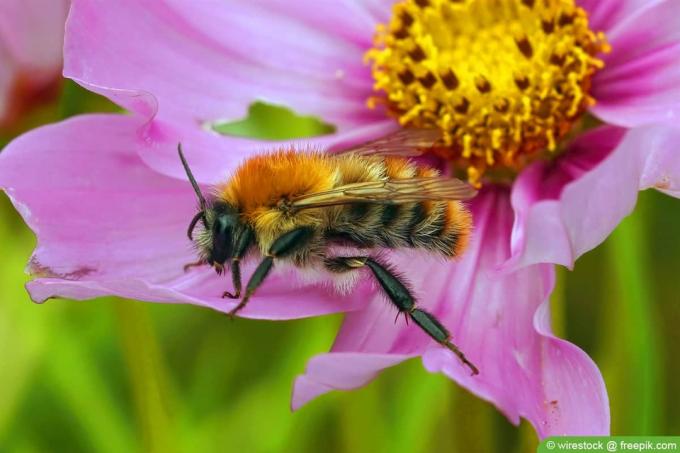
- Size: 9 to 18mm
- Appearance: Round, yellow to reddish brown, darkly striped, hairy
- Habitat: Forests, forest edges, meadows, gardens
Blue carpenter bee(Xylocopa violacea)

- Size: 20 to 28mm
- Appearance: round, resembles bumblebees, dark blue to black, blue shimmering wings
- Habitat: Settlement areas, gardens, meadow orchards, places with dead wood
Teal Mosaic Maiden(Aeshna cyanea)

- Size: 70 to 80mm
- Appearance: black ground colour, green-blue pattern, strong thorax
- Habitat: small bodies of water, standing or slowly flowing, garden ponds, rain barrels
German wasp(Vespula germanica)

- Size: 12 to 20mm
- Appearance: Strong physique, black and yellow abdomen, black thorax
- Habitat: Forest edges, shrubs, settlement areas, adaptable
bumblebee(Bombus magnus)

- Size: 16 to 23mm
- Appearance: round, black ground color, yellow bands, white rump, hairy
- Habitat: Forests, forest edges, meadows, gardens
Common lacewing(Chrysoperla carnea)

- Size: 10 to 30mm
- Appearance: Slender, green to brown, transparent wings, fully covering abdomen
- Habitat: Forest edges, meadows, parks, gardens, residential areas
Common Sand Bee(Andrena flavipes)
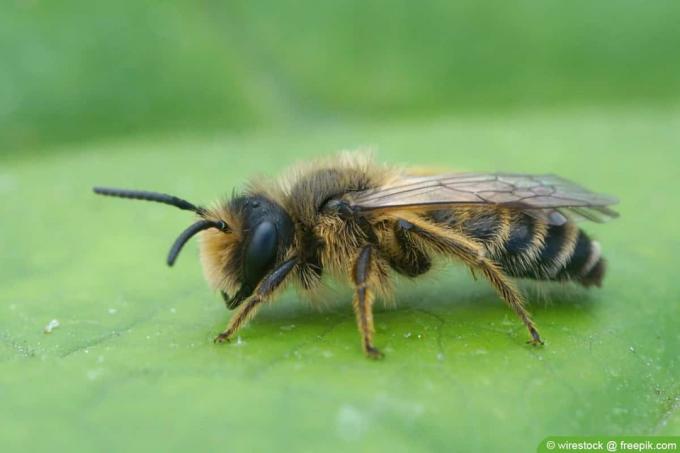
- Size: 6 to 18mm
- Appearance: resemble honey bees, hairy thorax, dark base color, yellow to light brown bands
- Habitat: sandy heaths, gravel pits, sand pits, forest edges, dry meadows
common wasp(Vespula vulgaris)

- Size: 14 to 20mm
- Appearance: slimmer than German wasp, yellow-black, forehead has a black line
- Habitat: Alluvial and mixed forests, city parks, meadow orchards, settlement areas, adaptable
Spotted-winged Antmaid(Euroleon nostras)
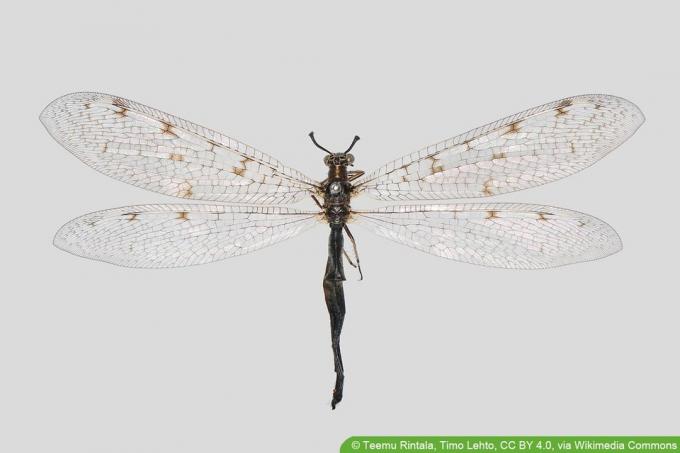
- Size: 25 to 32mm
- Appearance: Slender, dark brown to black, curved antennae, additional antennae on abdomen
- Habitat: lowlands, forests, south-facing slopes
- Special: Larvae known as ant lions
Large king dragonfly(Anax emperor)

- Size: 95 to 110mm
- Appearance: Slender, strong green thorax, blue abdomen
- Habitat: Sunny waters, calm or slow-flowing, riparian areas, garden ponds
grove hoverfly(Episyrphus balteatus)

- Size: 8 to 12mm
- Appearance: slender, resembles wasps, black-yellow
- Habitat: light forests, prefers deciduous trees
house wasp(Polistes dominula)

- Size: 11 to 18mm
- Appearance: slender, long hanging and orange colored legs, blackish-yellow coloring
- Habitat: Meadows, heath, settlement areas
honey bee(Apis mellifera)

- Size: 11 to 18mm
- Appearance: hairy thorax, brown-black coloration, abdomen lightly striped
- Habitat: Forests, meadows, need plants rich in nectar and pollen, beehives set up by humans
hornet(Vespa crabro)

- Size: 18 to 24mm
- Appearance: strong, red-brown thorax, red-yellow abdomen, long antennae
- Habitat: Mixed deciduous forests, meadows, preferably meadow orchards
A notice:
The Asian hornet (Vespa velutina var nigrithorax), which is becoming increasingly common, is larger than the native hornet. It is an invasive species of wasp that occurs primarily in south-west and west Germany.
Red mason bee(Osmia bicornis)

- Size: 10 to 12mm
- Appearance: Very hairy thorax, stocky, rust-red abdomen
- Habitat: Forest clearings, forest edges, settlement areas, adaptable
10 domestic beetles
garden beetle(Phyllopertha horticola)

- Size: 8 to 12mm
- Appearance: resembles cockchafers, short feelers, light brown elytra, black head
- Habitat: Forest edges, open landscapes, gardens
Common Bee Beetle(Trichodes apiarius)

- Size: 8 to 15mm
- Appearance: elongated, red and blue-black bands, slightly hairy, short antennae
- Habitat: dry meadows, forest edges, gardens, beehives (larvae)
Common gravedigger(Nicrophorus vespillo)

- Size: 10 to 22mm
- Appearance: black with orange spots, metallic sheen, pointed abdomen
- Habitat: open ground
Firefly(Lamprohiza splendidula)

- Size: 8 to 10mm
- Appearance: Gray-black males, cream-colored females and wingless, glowing at night
- Habitat: meadows, parks, gardens
Gold shiny rose chafer(Cetonia aurata)

- Size: 15 to 20mm
- Appearance: Sturdy, golden green in color, white transverse bands on the wings
- Habitat: Meadows, forest edges, gardens
stag beetle(Lucanus cervus)

- Size: 30 to 90mm
- Appearance: black-brown, males with pronounced mandibles (antlers)
- Habitat: Forests (preferably oak forests)
- Special feature: largest flying beetle in Germany
cockchafer(Melolontha melolontha)
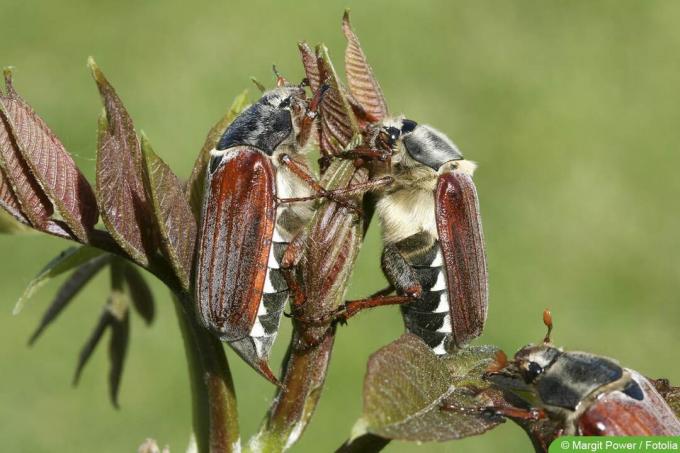
- Size: 25 to 32mm
- Appearance: strong, black ground colour, red-brown elytra, males have fans on antennae
- Habitat: open ground, gardens, forest edges
rhino beetle(Oryctes nasicornis)

- Size: 20 to 40mm
- Appearance: Dark brown, males have a horn on their heads
- Habitat: Forests, forest edges, places with a lot of dead wood
Seven-spot ladybug(Coccinella septempunctata)

- Size: 5 to 8mm
- Appearance: round, black head, red elytra with 3 dots each, 1 additional dot on the neck
- Habitat: open landscapes, gardens, parks, forests, close to prey such as aphids
forest dung beetle(Anoplotrupes stercorosus)
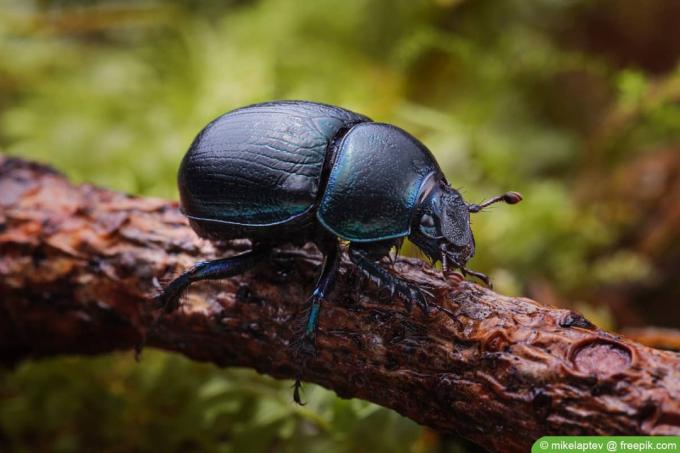
- Size: 15 to 20mm
- Appearance: black-blue basic coloration, rounded
- Habitat: forests
A notice: The Asian ladybird (Harmonia axyridis) established itself in Germany around the turn of the millennium. It is therefore an invasive, flying species of beetle.
8 pests and nuisances
bed bug(Cimex lectularius)

- Size: 4 to 9mm
- Appearance: oval, flat, dark red, strong legs
- Habitat: in human dwellings, stables, less often caves with groups of bats
German cockroach(Blatella germanica)

- Size: 12 to 16mm
- Appearance: light or dark brown, elongated, clearly visible wings, long antennae
- Habitat: in human dwellings, restaurants and hotels
Oak Processionary Moth(Thaumetopoea processionea)

- Wing span: 24 to 32 mm
- Appearance: grey-brown, stocky, inconspicuous, caterpillars with stinging hairs, also dark
- Habitat: Oak forests, single oaks (e.g. in garden)
Escaped(pulex irritants)

- Size: 3mm
- Appearance: tawny, strong jumping legs
- Habitat: in human dwellings
Ridged Weevil(Otiorhynchus sulcatus)

- Size: up to 10 mm
- Appearance: black, mottled with dark brown, clearly recognizable proboscis
- Habitat: woods, bushes
Common mosquito(Culex pipiens)

- Size: up to 7 mm
- Appearance: Slender, long legs, dark brown, with white bands, proboscis visible
- Habitat: near water, settlement areas
Gray Flesh Fly(Sarcophaga carnaria)

- Size: 8 to 20mm
- Appearance: light grey, thorax striped, abdomen checkered
- Habitat: forest edges, settlement areas, likes light
Large housefly(Musca domestica)

- Size: 8mm
- Appearance: gray to black, red eyes, covered with numerous bristles
- Habitat: Not picky, mostly in human dwellings
A notice:
Ticks and other mites (Acari) are also pests, but they are not insects. The parasites belong to the arachnids (Arachnida), which form their own class of animals.
5 butterflies presented
admiral(Vanessa atalanta)

- Wing span: 50 to 60 mm
- Appearance: dark brown, red band, with white bars and spots
- Habitat: open landscapes, forest edges, clearings, settlement areas
Little fox(Aglais urticae)

- Wing span: 40 to 50 mm
- Appearance: orange, dark edges and spots, white spot on wing tip
- Habitat: Meadows, forest edges, clearings, parks, gardens
dovetail(Papilio machaon)

- Wing span: 50 to 80 mm
- Appearance: light basic coloration, black and blue patterned, with tails at the wingtips
- Habitat: Dry meadows, gardens, other grassland
peacock butterfly(Aglais io)

- Wing span: 50 to 60 mm
- Appearance: rust red, 4 eyespots in yellow, blue and black
- Habitat: open landscapes to forests, adaptable
dovetail(Macroglossum stellatarum)

- Wing span: 36 to 76 mm
- Appearance: Reminiscent of a hummingbird, brown forewings with dark lines, yellow to red forewings, long proboscis
- Habitat: meadows, forests, city parks, gardens
6 domestic Schnabelkerfen
blood cicada(Cercopis vulnerata)

- Size: 9 to 11mm
- Appearance: Elongated, black ground color, wings patterned red
- Habitat: Meadows, pastures, ditches, sparsely wooded areas
Common fire bug(Pyrrhocoris apterus)

- Size: 8 to 20mm
- Appearance: oblong, black ground colour, red warning pattern
- Habitat: Forests, gardens, settlement areas, near food plants
Common water strider(Gerris lacustris)

- Size: 10mm
- Appearance: elongated, long legs, dark brown to black
- Habitat: small to medium-sized bodies of water, garden ponds
Green stink bug(Palomena prasina)

- Size: 12 to 14mm
- Appearance: oval, green, dark brown to black wings
- Habitat: Forests, herbaceous layer
Rhododendron Leafhopper(Graphocephala fennahi)

- Size: 8 to 10mm
- Appearance: light green, flat head, orange to red wing stripes
- Habitat: on food plants such as rhododendrons
stripe bug(Graphosoma italicum)

- Size: 8 to 13mm
- Appearance: oval, black ground colour, red striped
- Habitat: Meadows, roadsides, gardens
6 other types of insects
Brown-black carpenter ant(Camponotus ligniperda)
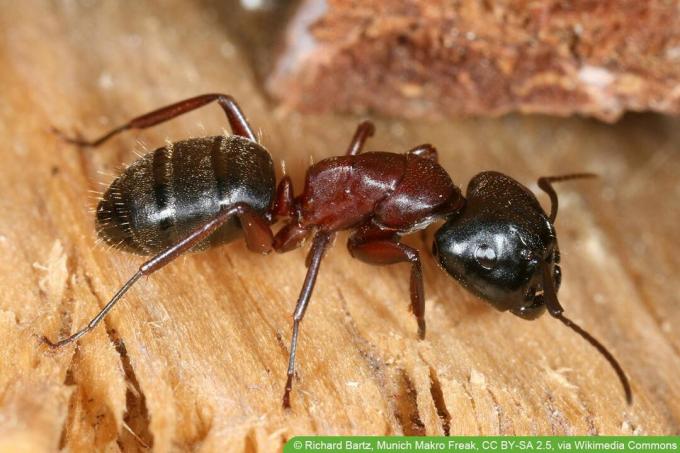
- Size: 6 to 16mm
- Appearance: Shiny, dark brown, slender
- Habitat: Mixed forests, dry grassland, gardens, open cultivated landscapes
European praying mantis(Mantis religiosa)

- Size: 60 to 75mm
- Appearance: green to brown, long antennae, strong fangs
- Habitat: Dry meadows, wine-growing areas, prefers sunny locations
field cricket(Gryllus campestris)

- Size: 18 to 27mm
- Appearance: stocky, glossy black, long antennae
- Habitat: Dry meadows, slopes, heaths, gravel pits, light coniferous forests
Mean catchy tune(Forficula auricularia)

- Size: 10 to 16mm
- Appearance: reddish brown, short wings, long antennae, pincers on the rump
- Habitat: piles of leaves, groves, settlement areas
Green Hay Horse(Tettigonia viridissima)
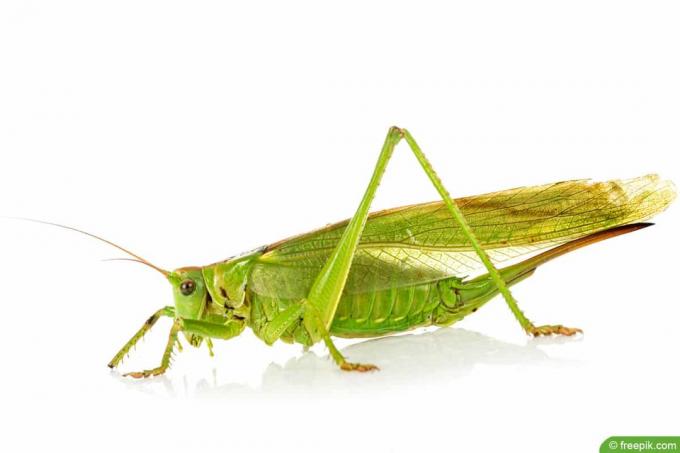
- Size: 30 to 40 mm, females with up to 30 mm ovipositor
- Appearance: green, back patterned light brown, long antennae, jumping legs and wings
- Habitat: Forest edges, dry grassland, parks, fallow land, rarely gardens
Black garden ant(Lasius niger)

- Size: 3 to 6 mm
- Appearance: dark brown, reddish brown legs and antennae, strong abdomen, dull
- Habitat: Meadows, forest edges, settlement areas
 Home editorial office
Home editorial office
Learn more about insects
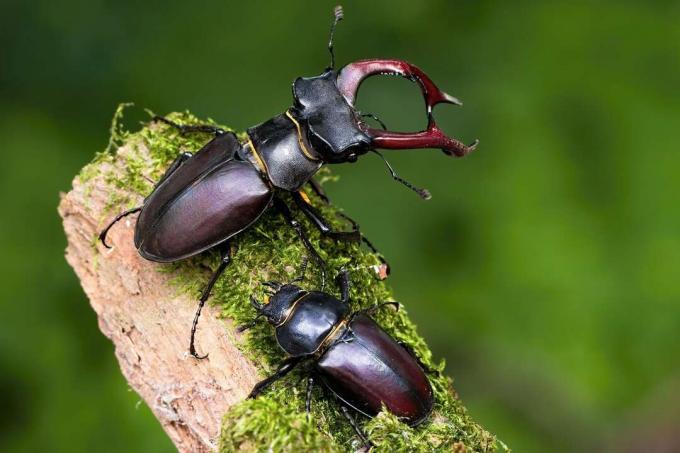
Identify beetles with pincers: 10 native species
Beetles are impressive insects. There are large and small, dark and dazzlingly colorful species. Some have pincer-like upper jaws for crushing or holding prey. The stag beetle is the largest among them. We present 10 native beetles with pincers.

Insect Hotel Filling: 10 filling materials
An insect hotel in your own garden offers numerous insects artificial shelter, nesting and wintering opportunities. They are more than necessary, because they are disappearing more and more as a result of massive human intervention in nature. They are essential for survival.

What do ladybugs eat and drink?
There isn't just one ladybug. Instead, there are several different species, not all of which eat aphids in the classic way. Some are even pure herbivores. Read here what else ladybugs like as food.

Fight field crickets in the lawn | What do crickets eat?
On warm summer days you can hear the chirping of field crickets. In places, the skittish insects appear in heaps. They dig holes in the lawn and their singing can be distracting. What do these strange insects eat? How do you get rid of them?

Spiders in Germany | Identify 18 species of spiders
Spiders cause disgust and disgust in many people. It often helps to take a closer look at these fascinating eight-legged creatures. Identify species that are common in Germany with us and learn about their appearance and habits.

46 bee-friendly plants by flowering season
With bee-friendly plants in the garden or on the balcony, wild bees and honey bees can make an important contribution. Both are threatened with extinction. In addition, you also support many other useful insects and birds.
